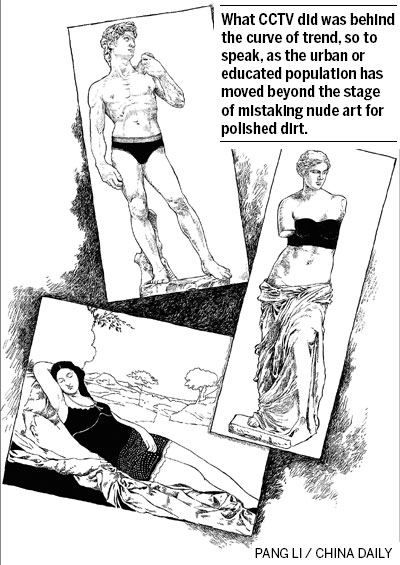

Surprising acceptance of the image of a nude sculpture on television reveals a continuous shift away from traditional rigidity.
On July 9, China Central Television (CCTV) news channel aired a news segment on the centennial celebration of the National Museum, which was to display several sculptures of renowned Italian Renaissance artists. One of them is Michelangelo's David-Apollo - not the ubiquitous David, mind you, but nude nonetheless.
The video that accompanied the news revealed the full body of the subject but with his genitalia pixilated.
This "mosaic" effect stirred up a debate online, with most opposing the act. In a repeat broadcast, CCTV removed the mosaic but did not offer explanation either for the erstwhile cover-up or for the later change.
It was the obvious deference to public opinion, rather than the ultra-conservative mindset behind the first decision, that took me by surprise.
While I deem the mosaic choice unnecessary, I can totally understand the rationale behind it.
China used to be a puritanical society.
Confucian values do not include the beauty of the human physique.
If anything, it is the opposite of the ancient Greek ethos.

Nowhere in classical Chinese art and literature can you find references to the exultation of the human body, male or female.
Yes, facial features were exquisitely portrayed and female figures were delicately sketched. But, except in pornography, the torso itself was rarely revealed, let alone a target of appreciation.
Then again, even in porn, the absence of perspective made an accurate depiction improbable.
The embrace of athleticism was an even stranger notion, as a strong male physique or physical power was invariably a manifestation of brute force or low-class travail.
As a result, the naked body has been inextricably associated with obscenity.
Even today, many people simply cannot distinguish between an artistic nude and a sleazy photograph that bares too much.
There were occasions in China when the naked body was, more or less, taken for granted. Half a century ago, before engine-powered boats were widely available, many of China's rivers had trackers who wore nothing but their birthday suits - to avoid getting in and out of water with soaked clothing sticking to them.
In some villages, women did not cover up their upper body fewer than 50 years ago.
Filmmaker Jiang Wen described his astonishment to me about stumbling into one such scene. It was not even in the hinterland, he said. And, of course, the women were not self-conscious at all.
Both of these cases were the result of forced circumstances. You won't see it anymore because such dire poverty no longer exists in the country.
Other occasions of public nudity may not be for the lack of money. But, as customs driven by socioeconomic forces, they are also on the way to extinction.
Public bathhouses separate customers by gender. But, within one sex, it is more natural for one to be naked than, say, chitchatting at the urinal.
However, if you grow up in a home with indoor plumbing and shower facilities, you may have a hard time overcoming the sense of squeamishness when disrobing in front of a milling crowd.
As life gets better, circumstance-induced public nudity gets rarer.
I don't know how many nude models do it because they can't get any other job that pays that scale. I'm sure one can easily opt out if he or she feels uncomfortable about this degree of nudity.
As a matter of fact, nude modeling was the first litmus test faced by the Chinese public back in 1914, when artist Liu Haisu introduced it in Shanghai.
By 1926, his sketching classes were shut down for "moral indecency" by the local authority, and he had to appeal to the press. With the founding of New China, this again became a target of scrutiny. It was Mao Zedong who personally approved this "Western methodology" of learning how to paint.
Now, suppose the chairman had second thoughts about the practice. I'm sure there would have been an avalanche of public denunciation of such an expression of "Western decadence" as painting naked women. Even with the weight of the chairman's endorsement, the practice was not really public, but known among a very small circle.
When the country opened up and fine arts books trickled in, people became fixated on the nude photos and sculptures.
In bookstores, the fine arts sections were always packed with eager browsers.
Then, fine arts academies started recruiting nude models.
I remember a student from a local academy came by the school I was attending and was mobbed with questions, such as: "What if you have a physical reaction while you draw her?"
The curiosity factor subsided when real porno made its entrance, first via smuggled magazines and disks, and then the Internet, which opened the floodgate.
Even though porn has never been legalized in China - not on the mainland at least - there are constant efforts to push the envelope to include more titillation and peel off as much clothing as censors permit.
One not versed in high culture may well be befuddled by objets d'art that feature nudity and erotica that does not reveal everything.
One may ask: Where is the line of moral decency? The easiest way to draw the line, it seems, is whether certain body parts are visible.
They may not realize that salacity can exude from more than the private parts of the body. The eye, the mouth, the hand gesture, the pose, all can convey a sense that the old school would consider amoral - if you know how to read it.
A rush of spoof in the aftermath of the CCTV mosaic incident has many classic paintings covering up sexual organs of human figures with "tastefully" conceived garment.
Many of these are humorous, but some are slightly prurient.
A cutoff of Michelangelo's Sistine Chapel Ceiling places a necktie on the naked Adam, concealing his penis and at the same time making him a stripper. The poses of newly clothed ladies assume an erotic overtone, to say the least.
Public television stations are not known for being bastions of the avant-garde.
It is quite natural for CCTV programmers to err on the side of caution.
Had the same footage been shown 20 years ago, the outcry might have been over the lack of a fig leaf, which, if you think of it, is the ancient equivalent of the mosaic treatment.
The young generation, under growing outside influences, shows changing attitudes toward the human body. More pervasive is the if-you've-got-it-flaunt-it mindset. Western paintings and statues are so widely accessible and so often imitated that replicas adorn real estate projects that aspire to Western opulence.
The evolution for better discernment for art and more tolerance for body image is gradual and takes many baby steps.
Rarely does a month go by without a controversy that involves some form of nudity.
What CCTV did was behind the curve of trend, so to speak, as the urban or educated population has moved beyond the stage of mistaking nude art for polished dirt.
However, the fundamental struggle remains as a still sizable audience without proper education of fine arts fails to differentiate the art of aesthetic enjoyment and the art of arousal.
The public may well take the side of censors when a contemporary artist creates a nude in the non-classical style.
Contact the writer at raymondzhou@chinadaily.com.cn.
